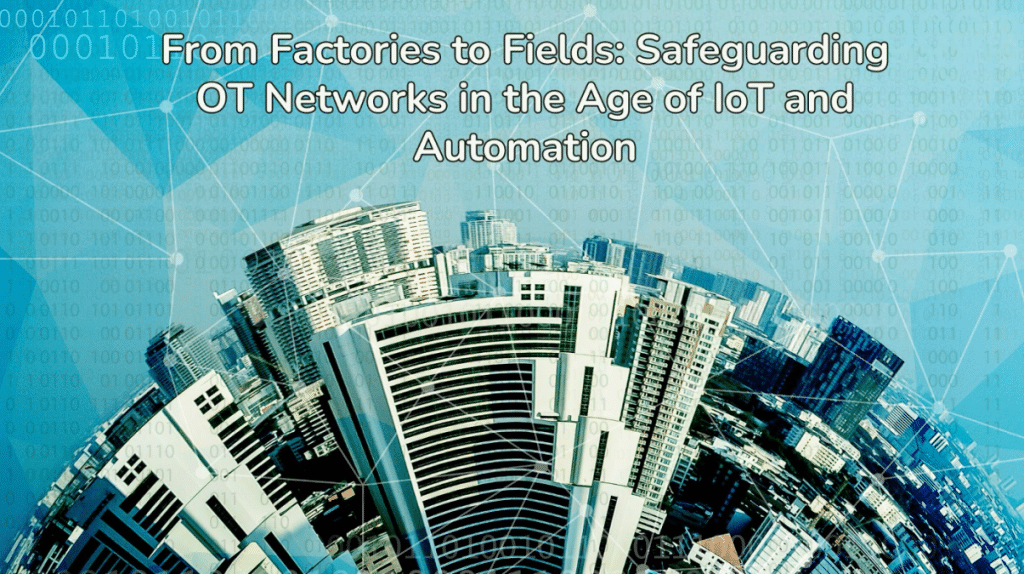As the digital transformation accelerates across industries, the convergence of operational technology (OT) and information technology (IT) has become an inevitable reality. From factories to farms, IoT and automation boost efficiency. They offer data insights and remote monitoring. Yet, they bring new cybersecurity risks, exposing OT networks to threats.
In this blog post, we address the concerns of IT and OT professionals, decision-makers, and stakeholders across various sectors. We provide insights and best practices for protecting OT networks. This is in the age of IoT and automation.
The Convergence of IT and OT

In the past, operational technology (OT) networks isolated industrial processes and machinery from the broader information technology (IT) systems within an organization. With the rise of the Internet of Things (IoT) and more automation, IT and OT are merging.
Industrial control systems (ICSs) and SCADA now link with IT networks, cloud platforms, and the internet. This fusion offers benefits: improved efficiency, data-driven choices, and remote monitoring. Yet, it also ushers in fresh cybersecurity hurdles. OT networks, once secure in their isolation, now face a broader array of cyber threats.
Securing the Connected Factory

To effectively secure OT networks in the age of IoT and automation, organizations must bridge the gap between IT and OT teams. Historically, these teams have operated in silos, with different priorities, skill sets, and operational mindsets. However, in the era of converged IT-OT environments, collaboration and shared understanding are crucial for robust OT cybersecurity.
IT teams must gain a deeper understanding of the unique requirements and constraints of OT systems, while OT teams must embrace modern cybersecurity practices and technologies. By fostering cross-functional collaboration and knowledge sharing, organizations can develop holistic security strategies that address the unique challenges of OT environments while leveraging the expertise of both IT and OT personnel.
The Rise of Precision Agriculture

The agricultural sector has also undergone a digital transformation, adopting precision agriculture technologies and IoT-enabled farming equipment. Precision agriculture leverages data from sensors, drones, and other connected devices to optimize crop yields, reduce waste, and improve overall efficiency.
However, this increased connectivity and automation in agricultural operations introduce new cybersecurity risks. Cyber attacks targeting agricultural systems could potentially disrupt food production, compromise sensitive data, and even pose risks to public health and safety.
Securing Agricultural OT Networks

Securing OT networks in the agricultural domain requires a multifaceted approach that considers the unique challenges and constraints of farming operations. Here are some key considerations:
Ruggedized Security Solutions
Agricultural environments are often harsh and remote, necessitating the deployment of ruggedized security solutions that can withstand extreme temperatures, humidity, and other environmental factors. Security solutions must also be designed to operate with limited connectivity and power resources.
Remote Access and Monitoring
With agricultural operations often spanning vast areas, remote access and monitoring capabilities are essential. Secure remote access solutions, combined with centralized monitoring and management systems, can enable efficient oversight and control of distributed OT networks in agricultural settings.
Supply Chain Security
The security of agricultural OT networks extends beyond the farm itself. Organizations must also consider the security of their supply chains, ensuring that connected farming equipment, sensors, and other IoT devices are sourced from trusted vendors and have undergone rigorous security testing and validation.
Workforce Education and Awareness
Educating and training agricultural workers on cybersecurity best practices is crucial for maintaining the security of OT networks. This includes raising awareness about potential cyber threats, implementing secure operational procedures, and fostering a culture of security within the organization.
Implementing Defense-in-Depth Strategies

Securing OT networks requires a defense-in-depth approach that combines multiple layers of security controls and technologies. This approach recognizes that no single security measure is foolproof and aims to create overlapping layers of protection.
Network Segmentation and Access Control
Network segmentation and stringent access control measures are crucial for isolating critical OT systems from potential threats. This can involve creating separate zones or Demilitarized zones (DMZs) for different OT components, implementing firewalls, and enforcing strict access control policies based on the principle of least privilege.
Endpoint Protection and Vulnerability Management
Endpoint protection solutions tailored for OT environments can help secure industrial control systems, PLCs, and other OT devices against malware and cyber threats. Regular vulnerability assessments and patch management processes are also essential for identifying and mitigating known vulnerabilities in OT systems.
Monitoring and Incident Response
Continuous monitoring and robust incident response capabilities are vital for detecting and responding to cyber incidents in OT environments. This may involve deploying security information and event management (SIEM) solutions, implementing intrusion detection and prevention systems (IDS/IPS), and establishing incident response plans tailored for OT environments.
Adopting Secure-by-Design Principles

While addressing the security challenges of existing OT systems is crucial, organizations must also look to the future and embrace secure-by-design principles for new OT deployments. As IoT and automation technologies continue to evolve, security considerations should be integrated from the ground up, rather than being an afterthought.
This includes implementing secure coding practices, conducting thorough security testing and validation, and incorporating security features such as encryption, authentication, and access control into the design of OT systems and IoT devices. By adopting a secure-by-design mindset, organizations can future-proof their OT environments and reduce the risk of vulnerabilities and cyber threats.
The Unique Challenges of OT Security

OT environments present unique security challenges that differ from traditional IT environments. Many OT systems were designed with little to no security considerations, as they were intended to operate in isolated environments. Additionally, these systems often have long lifecycles, making it difficult to apply regular security updates or patches without risking operational disruptions.
Moreover, the “air-gapped” nature of OT networks is rapidly disappearing, as organizations seek to leverage the benefits of connectivity and data exchange. While beneficial for operations, this increased connectivity expands the attack surface and introduces new vulnerabilities.
Emerging Trends in OT Security
● 5G and increased wireless connectivity expand the attack surface
● Edge computing introduces challenges for securing distributed OT components
● AI/ML integration risks adversarial attacks exploiting model vulnerabilities
● Digital twins enable pre-deployment security testing and simulation
● Collaboration with vendors/experts is key to addressing emerging OT risks
Wrapping Up
The digital transformation is sweeping across industries. Safeguarding OT networks has become a critical need. Bridging the IT-OT gap boosts cyber resilience for agriculture. By employing defense-in-depth strategies and secure-by-design principles, organizations safeguard their operations.
Addressing agricultural OT network challenges is crucial for protection. Cybersecurity is crucial for IoT and automation success. Address OT security challenges, and collaborate between IT and OT teams. This unlocks transformative tech potential, minimizing associated risks effectively.
Key Takeaways
- The convergence of IT and OT has blurred traditional security boundaries, exposing OT networks to cyber threats.
- OT systems pose unique security challenges. They have legacy designs and long lives. Also, “air-gapped” environments are disappearing.
- Collaboration and knowledge sharing are crucial. They bridge the gap between IT and OT teams. This is vital for effective OT security.
- A defense-in-depth approach is essential. It combines many layers of security controls and technologies. It’s key for securing OT networks.
- Embrace secure-by-design for new OT deployments. Integrate security from the ground up.
- Agricultural OT networks need special security solutions. The solutions must be tailored to harsh environments and remote operations. They must also consider supply chain security.
- Education and awareness are critical for keeping OT networks secure. They are critical for all industries.
FAQs
- Why is OT security becoming more crucial in the era of IoT and automation?
OT systems are getting more connected to IT networks, cloud platforms, and the internet. This exposes them to more cyber threats. IT and OT have converged. This has blurred traditional security boundaries. It requires a holistic approach to cybersecurity.
- What are the unique challenges of securing OT environments?
OT systems were often designed with little to no security considerations, as they were intended to operate in isolated environments. Additionally, these systems have long lifecycles, making regular security updates and patching challenging. The “air-gapped” nature of OT networks is also rapidly disappearing, expanding the attack surface. - How can organizations bridge the gap between IT and OT teams for effective security?
Fostering cross-functional collaboration and knowledge sharing between IT and OT teams is crucial. IT teams must understand the unique requirements and constraints of OT systems, while OT teams must embrace modern cybersecurity practices and technologies. This cross-pollination of expertise can lead to holistic security strategies. - What is a defense-in-depth approach, and why is it important for OT security?
Defense-in-depth uses many layers of security controls and technologies. It recognizes that no one security measure is foolproof. It involves using layers of protection. These include network segmentation, access control, endpoint protection, vulnerability management, monitoring, and incident response. - How can organizations address OT security challenges in the agricultural sector?
Securing agricultural OT networks needs tough security solutions. They must withstand harsh environments. They also need remote access and monitoring. They need supply chain security. And they need education and awareness programs for farming.

